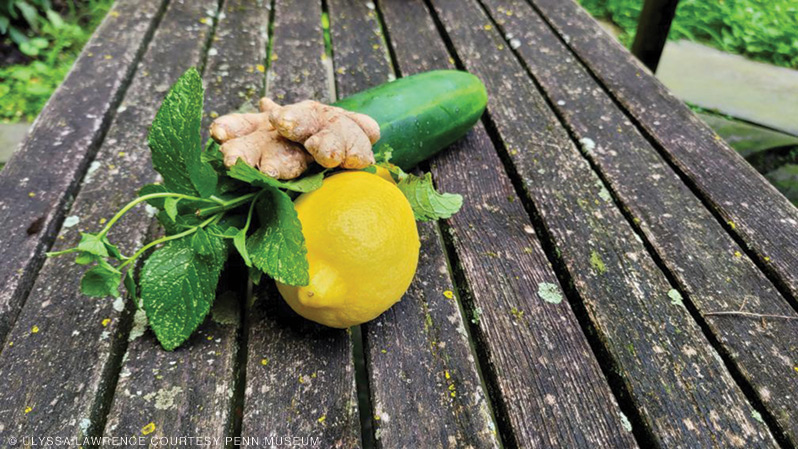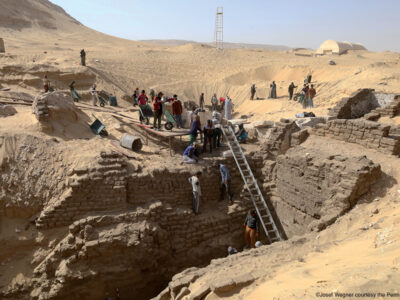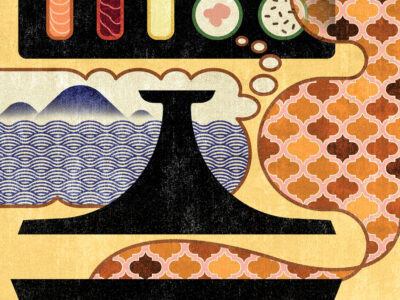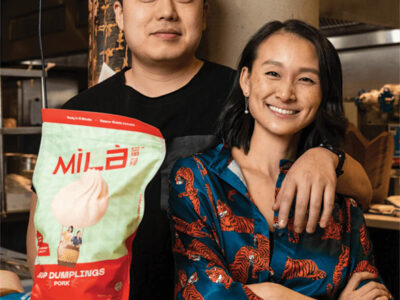West Philly high school students got a taste of food culture and visual storytelling during a Penn Museum pilot program.
Despite the humidity, some 250 revelers gathered in the courtyard of the Penn Museum for one of its popular Garden Jams in late July. They listened to an Afro-centric drumming group and noshed on offerings from several ethnic food trucks. Inside, they meandered through a special exhibition called “Ancient Food & Flavor.”
Meanwhile, serving as “station guides” for the exhibition on what ancient communities were growing, eating, and drinking were several pairs of ebullient teenagers who were telling museum visitors about their own relationships with food.
“Our food journey is about sugar,” Kobe, a 10th grader, said. “I knew that just about everything we eat has sugar, but I had no idea that it comes from a plant called sugar cane and that some people chew on it and spit it out.” Her schoolmate, Samaar, relayed a story about his mom’s baking. “Mmmmmm, so goooood,” he said, puffing out his cheeks in memory of stuffing his mouth with chocolate chip cookies. “She would try to stop me from eating so much. She’d go, ‘Calm down, they’re not that good.’”
Those lighthearted interactions with museumgoers were just a part of “Your Food Story,” a partnership between the museum, Sayre High School, the Netter Center, the Agatston Urban Nutrition Initiative (AUNI), and the TILT Institute of the Contemporary Image. The multifaceted six-week summer program brought together 12 Sayre students for field trips and conversations about photography, food culture, and museum research. The pilot aimed to introduce these West Philadelphia students—several of whom were already engaged in an urban gardening project through AUNI—to topics ranging from how museum exhibitions are created, to what kinds of museum careers are open to them, to our connections to food and the past, to the craft of visual storytelling.

“In doing an analysis of the new audiences we were looking to engage, the big one was teens, especially our West Philadelphia youth,” said Tia Jackson-Truitt, the Penn Museum’s inaugural chief diversity officer. “We had already reached 40,000 middle school students through our wildly successful in-school ‘Unpacking the Past’ program [“Gazetteer,” Jan|Feb 2015] and we wanted to continue with that pipeline to keep older kids engaged by figuring out what interests them.”
The special exhibition that went up this summer provided the hook they were looking for, added Jennifer Brehm, the museum’s director of learning and community engagement. “Food is a great connector, an experience that we all have and enjoy,” she said.
For a final project, the organizers decided to mount a photography exhibition at the museum in mid-August for Sayre students and their families, before transferring it to Sayre for installation. “One young woman took a photo of ginger and then talked about how even honey didn’t make it taste better when it was presented as a remedy in her West Indian culture,” Brehm said.
The installation only had room for one photo per student, Brehm continued, “so although we’re encouraging them to take their cameras everywhere, it may be that they share their story in writing, with just an image of a single plant. We want them to have agency.”

The teenagers’ shyness didn’t seem to hamper their creativity. At the late-July museum event, Kobe and Samaar giggled excitedly as they discussed the photo submission that they’d staged and shot: an AriZona juice bottle that they’d thirstily drained then refilled with a small pile of granulated sugar representing the rough sugar content of the drink. “We’re so glad we picked this ingredient,” Samaar said. “What could be more fun to research?”
For Jackson-Truitt, such sugary sentiments have been music to her ears. “We hope they learn life skills and career readiness,” she said. “But primarily, we want them to use their voice, even if it shakes. Ultimately my intention is to make this museum and the campus feel welcoming to everyone. We want to attract people who can see themselves in the collection: indigenous, African Americans, all of the voices of the community.”
—JoAnn Greco




